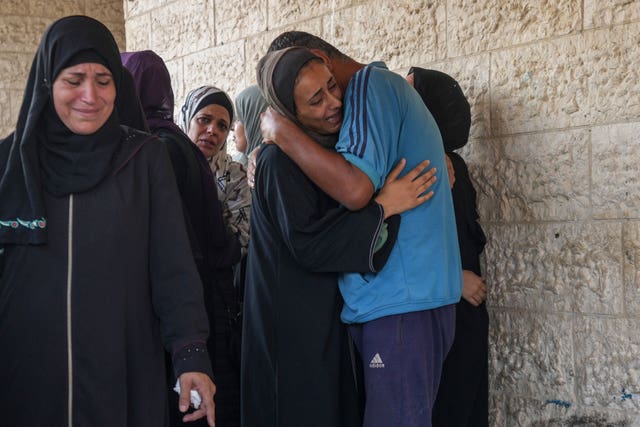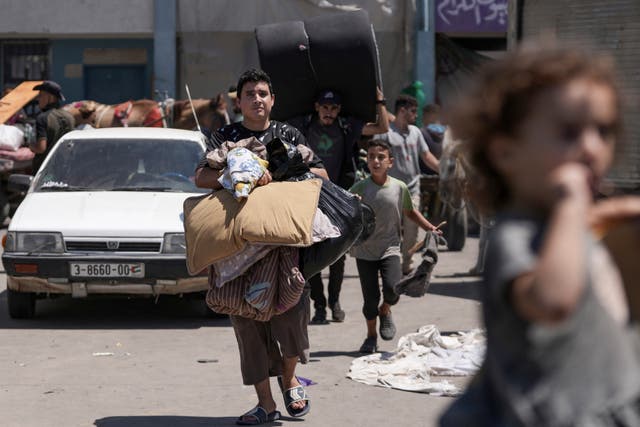Israeli air strike kills at least 18 in Gaza despite hopes for ceasefire deal
The attack came hours after officials from the US, Egypt and Qatar ended two days of ceasefire talks with hope that a deal could be reached.

An Israeli air strike has killed at least 18 people from the same family in the Gaza Strip.
The attack came days after the Health Ministry in Hamas-run Gaza announced the death toll surpassed 40,000 in the 10-month-old Israel-Hamas war, and just hours after officials from the United States, Egypt and Qatar wrapped up two days of ceasefire talks with a message of hope that a deal could be reached.
A joint statement from the three mediators said a proposal to bridge the gaps between Israel and Hamas was presented and they expected to work out the details of how to implement the possible deal next week in Cairo.
It is also aimed at tamping down regional tensions that have threatened to explode into a broader war amid fears that Iran and Hezbollah militants in Lebanon would attack Israel in retaliation for the killings of top militant leaders.
The air strike in Gaza early on Saturday morning hit a house and an adjacent warehouse sheltering displaced people at the entrance of the town of Zawaida, according to the Al-Aqsa Martyrs Hospital in Deir al-Balah, where the casualties were taken. An Associated Press reporter at the hospital counted the deaths as they were brought in.
Among those killed was a wholesaler identified as Sami Jawad al-Ejlah, who co-ordinated with the Israeli military to bring meat and fish to Gaza. The dead also included his two wives, 11 of their children aged two to 22, the children’s grandmother, and three other relatives, according to a death list provided by the hospital.
“He was a peaceful man,” said Abu Ahmed, a neighbour who was slightly wounded in the attack.
More than 40 civilians were sheltering in the house and warehouse at the time of the strike, he said.
The Israeli military, which rarely comments on individual strikes, said it struck “terrorist infrastructure” in central Gaza where rockets had been fired toward Israel in recent weeks. It said it was continuing attacks on militants in central Gaza.

The Israeli military, which rarely comments on individual strikes, said it was checking on the report. It said on Saturday that it was continuing attacks on militants in central Gaza, including one seen launching rockets at troops.
Meanwhile, another mass evacuation was ordered for areas in central Gaza. In a post on X, Israeli military spokesperson Avichay Adraee said Palestinians in areas in and around the urban Maghazi refugee camp should leave. He said Israeli forces will operate in these areas in response to Palestinian rocket fire.
The vast majority of Gaza’s population has been displaced by the fighting, often multiple times, and around 84% of Gaza’s territory has been placed under evacuation orders by the Israeli military, according to the United Nations.

Israel says it has killed more than 17,000 Hamas militants in the war, without providing evidence.
Mediators have spent months trying to hammer out a three-phase plan in which Hamas would release the hostages in exchange for a lasting ceasefire, the withdrawal of Israeli forces from Gaza and the release of Palestinians imprisoned by Israel.
But efforts took on new urgency in recent weeks as diplomats hoped a deal would persuade Iran and Lebanon’s Hezbollah to hold off on retaliating for the killing of a top Hezbollah commander in an Israeli air strike in Beirut and of Hamas’s top political leader in an explosion in Tehran that was widely blamed on Israel.
An American official said on Friday that the ceasefire deal currently presented to the two sides bridges all the gaps between Israel and Hamas. In what appeared to be a sign of confidence, mediators were preparing to implement the proposed agreement even before it was approved, said the official.
The official said an “implementation cell” was being established in Cairo to focus on logistics — including freeing hostages, providing humanitarian aid for Gaza and ensuring that the terms of the pact are met.
But Hamas cast doubt on whether an agreement was near.
In a statement, the militant group said the latest proposal diverged significantly from a previous iteration they had agreed to in principle, implying they were not inclined to accept it.
The Israeli prime minister’s office issued a statement saying it “appreciates the efforts of the US and the mediators to dissuade Hamas from its refusal to a hostage release deal”.
Both sides agreed in principle to a plan announced on May 31 by US President Joe Biden. But Hamas has proposed amendments, and Israel has suggested clarifications, leading each side to accuse the other of trying to tank a deal.
The US official said the latest proposal is the same as Mr Biden’s, with some clarifications based on ongoing talks. The way it is structured poses no risk to Israel’s security but enhances it, the official added.
Hamas has rejected Israel’s demands, which include a lasting military presence along the border with Egypt and a line bisecting Gaza where it would search Palestinians returning to their homes to root out militants.
But Israel showed flexibility during the talks on retreating from the border corridor, and a meeting between Egyptian and Israeli military officials was scheduled for the following week to agree on a withdrawal mechanism, according to two Egyptian officials.
Israel insisted on keeping control of the road bisecting Gaza, but American mediators vowed to return to the talks next week with a compromise on that demand, the officials said.
As part of an increased wave of diplomacy aimed at securing the deal, French foreign minister Stephane Sejourne met with Egyptian foreign minister Badr Abdelatty in Cairo on Saturday.
Sejourne and UK Foreign Secretary David Lammy met with officials in Israel on Friday. US secretary of state Antony Blinken planned to travel to Israel over the weekend and was expected to meet with Israeli Prime Minister Benjamin Netanyahu on Monday.





